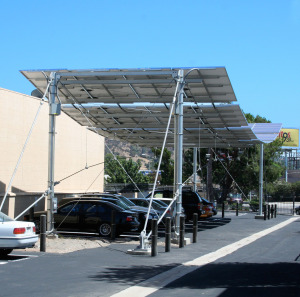Oct 22 2009
The First, Cable-Suspended Free Span Solar Energy System Was Completed Today over the REM Eyewear Headquarters
The first, cable-suspended free span solar energy system was completed today over the REM Eyewear headquarters parking lot. The patented, cable-supported photovoltaic system created by P4P Energy is expected to generate 40,877 kilowatt-hours of renewable electricity per year, enough to power five to six single family homes and to prevent 1.5 million pounds of carbon from being released into the atmosphere.
 The TenSol Mesa is a solar panel parking canopy featuring a series of tensioned cables for support. This system can be used over aqueducts, parking lots and almost any terrain with minimal site and environmental disturbance. Outputs range from 100 kilowatts systems to multiple megawatt power plants
The TenSol Mesa is a solar panel parking canopy featuring a series of tensioned cables for support. This system can be used over aqueducts, parking lots and almost any terrain with minimal site and environmental disturbance. Outputs range from 100 kilowatts systems to multiple megawatt power plants
The revolutionary, uniquely aesthetic solar panel system is designed to utilize otherwise untapped air-space, in future applications that include coverage over aqueducts, irregular terrain, agricultural and brown fields, parking lots, and pedestrian malls and walk ways.
“Being on the cutting edge is part of our DNA,” said Mike Hundert, Chief Executive Officer of REM Eyewear, “whether it is the design of our eyewear, or the manner in which we do business. Our investment in this remarkable solar system at our headquarters is consistent with our philosophy that companies that do well also have an obligation to do good.”
The state-of-the-art P4P Energy TenSol-brand suspension system differs from conventional solar installations by eliminating the need for excessive use of columns and foundations that traditionally support photovoltaic panel arrays. Instead, hundreds of panels can lie atop low-cost cables that span as much as 200 feet across, helping bring economic parity between the cost of solar energy and fossil fuel-generated power.
“Also appealing are the multiple-use capabilities of TenSol designs,” said Steven Conger, P4P Energy’s founder and chief executive officer. “Our streamlined systems can be built over parking lots and agricultural fields provide shade and shelter, while converting the airspace into an energy company. Over aqueducts, the system has the extra benefit of significantly reducing evaporation – saving as much as eight million gallons of water per year, per mile of aqueduct.”
Conger added, “P4P Energy systems are designed in such a way to fluidly integrate community solar systems with the urban landscape. By easing the processes of design, construction, location choice and environmental impact, we believe we can effectively transform the economic viability of solar energy. Last but not least, this system doesn’t just look revolutionary; it is revolutionary.”
Source: https://www.derigo.com/en